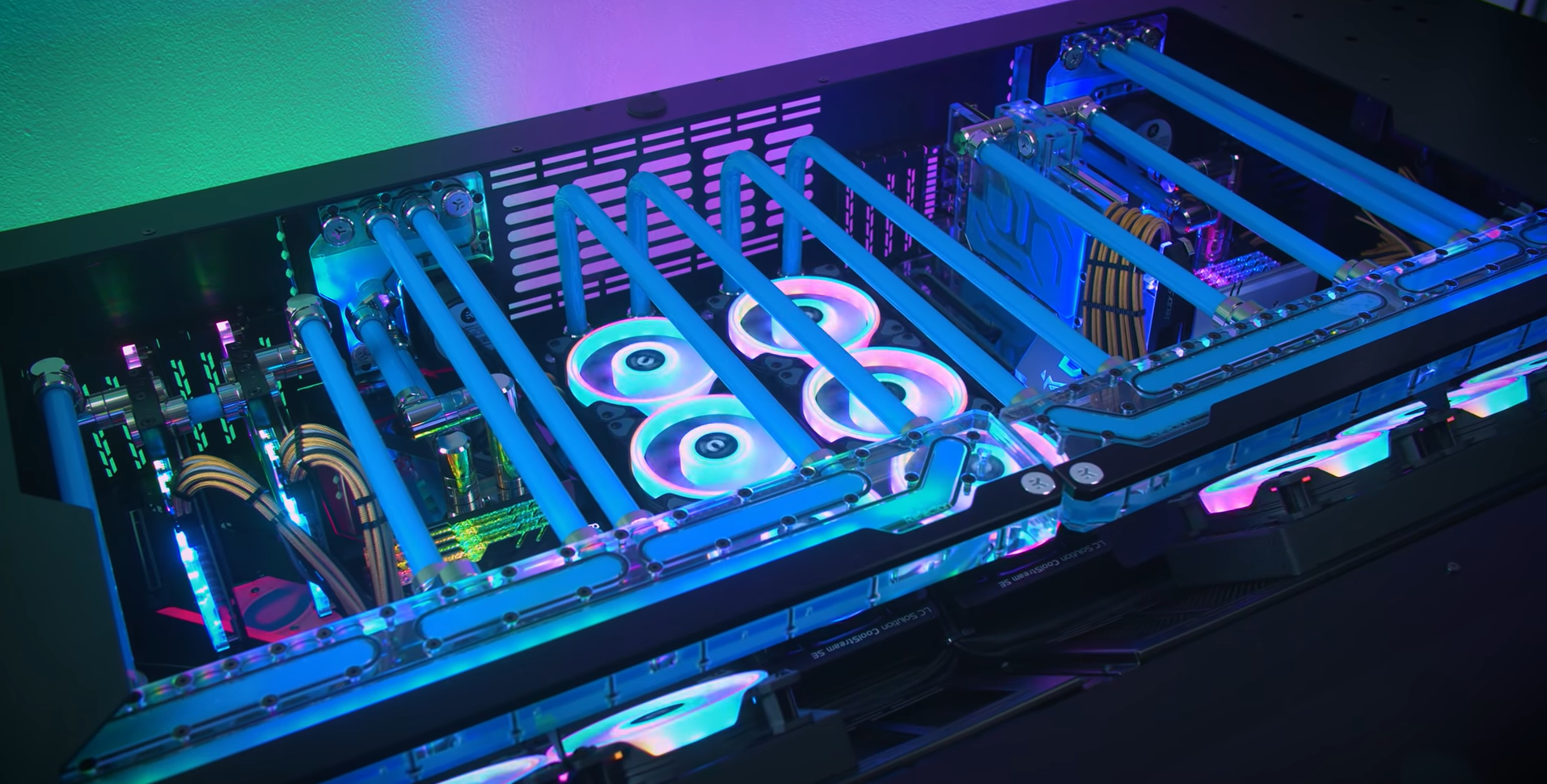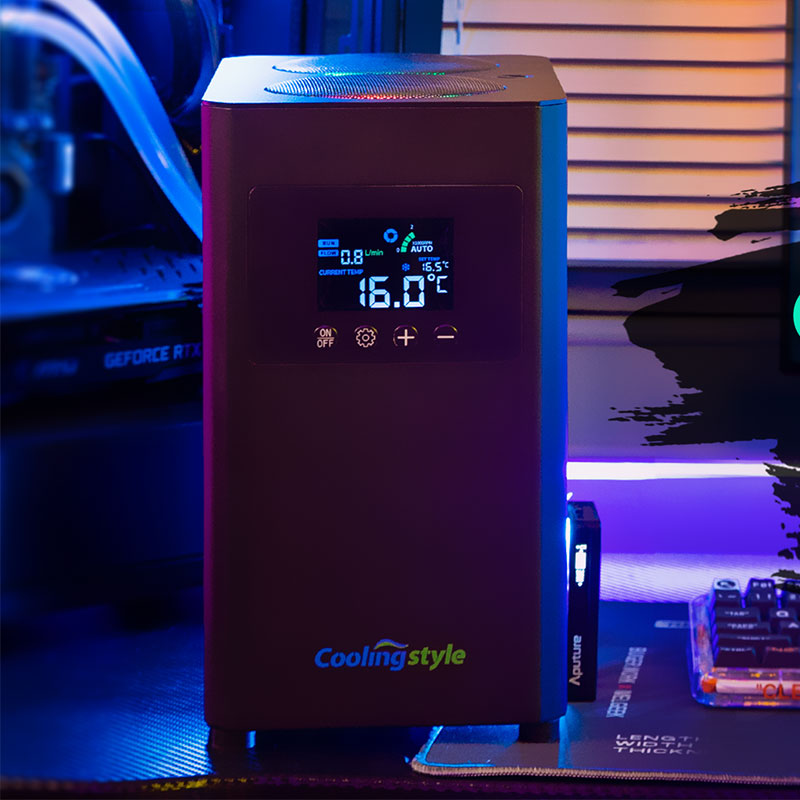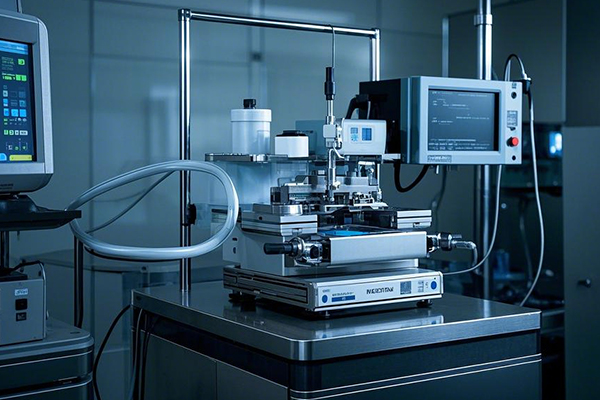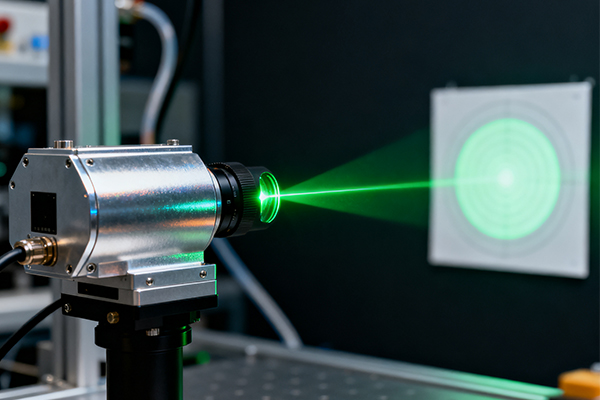Jeder Computer, Egal, erzeugt Wärme während des Betriebs. Ohne ordnungsgemäßes Wärmemanagement, Dies kann die wertvollen internen Komponenten Ihres PCs beschädigen.
Wenn Sie einen vormontierten Computer von einem Einzelhändler oder Hersteller wie HP gekauft haben, Ihre Kühllösung ist bereits erledigt. Wenn Sie jedoch einen leistungsstarken Custom -PC bauen oder aktualisieren, Sie stehen vor einer wichtigen Entscheidung:

Sollten Sie ein Hochleistungs-Flüssigkühlsystem über der herkömmlichen Luftkühllösung auswählen?
Vor der Antwort, Tauchen wir in die wichtigsten Unterschiede und Faktoren ein, die berücksichtigt werden müssen.
Flüssigkeitskühlung vs. Luftkühlung: Schlüsselunterschiede
Luftkühlsysteme
Luftkühlung ist die traditionelle Methode zur Wärmeverwaltung. Es stützt sich auf einen CPU -Fan, ein Kühlkörper, und zusätzliche Chassis- und GPU -Lüfter, um warme Luft auszuschließen.
- Mechanismus: Der CPU -Lüfter arbeitet zusammen mit einem Metallkühlkörper zusammen, um Wärme von kritischen Komponenten abzuziehen. Die heiße Luft wird dann aus dem Gehäuse herausgedrückt, Den inneren Temperatur stabil halten.
- Leistung: Da Komponenten mehr Wärme erzeugen, Fans drehen sich schneller, mehr Geräusche erzeugen, aber eine effektive Wärmeabteilung sicherstellen.
Flüssigkühlsysteme
Flüssigkeitskühlsysteme, im Gegensatz, Verwenden Sie mit mit Kühlmittel gefüllte Röhrchen, Heizkörper, und Wasserblöcke zur Regulierung der Temperatur.
- Mechanismus: Flüssigkeit zirkuliert durch das System, Wärme direkt von Komponenten absorbieren. Es reist dann zu einem Kühler, in dem die Wärme vor dem Abkühlen der Flüssigkeit verteilt ist und sich umleitet.
- Leistung: Flüssigkühlung ist im Allgemeinen effizienter, leiser, und visuell ansprechend, oft von Enthusiasten und Spielern bevorzugt.
Wie flüssige Kühlung funktioniert
Die Flüssigkühlung bietet eine modernste Lösung für das thermische Management, Kombination der Funktionalität mit Ästhetik. So funktioniert es:
Kernkomponenten
Ein Standard -Flüssigkühlsystem umfasst:
- Wasserkühler: Zirkuliert Kühlmittel durch das System.
- Kühler: Löst die vom Kühlmittel absorbierte Wärme auf.
- Fans: Helfen bei der Kühlung des Kühlers.
- Reservoir: Speichert überschüssiges Kühlmittel.
- Wasserblöcke: Übertragen Sie die Wärme von Komponenten auf die Flüssigkeit.
- Schläuche: Schließen Sie das System an und sorgen Sie für den Kühlmittelfluss.
Arbeitsprinzip
- Wärmeaufnahme: Wärmepaste verbessert die Wärmeübertragung von der CPU/GPU zum Wasserblock.
- Kühlmittelfluss: Die Pumpe bewegt Kühlmittel durch den Wasserblock, wo es Wärme absorbiert.
- Wärmeissipation: Der erhitzte Kühlmittel reist zum Kühler, wo Fans die Hitze in die Luft zerstreuen.
- Umwälzung: Die gekühlte Flüssigkeit fließt zurück, um den Vorgang zu wiederholen.

Vorteile von Flüssigkühlsystemen
- Kompaktes Design
Flüssigkühlsysteme sind weniger sperrig als Luftkühlung, Platz für zusätzliche Komponenten freigeben. - Leiser Betrieb
Im Gegensatz zur Luftkühlung, die wie ein Strahlmotor unter schweren Lasten klingen kann, Flüssigkühlung ist viel leiser. Das Rauschen ist auf die Pump- und Kühlerventilatoren beschränkt, die kaum spürbar sind. - Gezielte Kühlung
Flüssigkühlung ermöglicht eine präzise Kontrolle, Konzentration auf wärmeempfindliche Komponenten wie CPU und GPU. - Effiziente Wärmeabteilung
Flüssigkühlung sorgt für einen kontinuierlichen Kühlmittelfluss, Verhinderung der Umwälzung warmer Luft und Verringerung der thermischen Schäden. - Reinigungsmittel
Luftkühlsysteme sammeln sich im Laufe der Zeit dazu, Staub zu sammeln, Während flüssige Kühlungsaufnahmen sauberer bleiben, Aufrechterhaltung der ästhetischen Attraktivität Ihres PCs.
Überlegungen bei der Auswahl der Flüssigkühlung
Benutzerdefinierte Schleifen vs. AIO -Systeme
- Alles in einem (AIO) Systeme: Vorgepasst und einfach zu installieren, AIOs sind für die meisten Benutzer erschwinglich und praktisch.
- Benutzerdefinierte Schleifen: Sehr anpassbar, aber teuer und komplex zu errichten. Diese eignen sich am besten für Enthusiasten, die eine maximale Leistung erfordern.
Kühlmitteloptionen
- Destilliertes Wasser: Bevorzugt für seine Reinheit, Minimierung des Risikos von Blockaden.
- Zusatzstoffe: Spezialkühlmittel können die Ästhetik verbessern, niedrigere Gefrierpunkte, und umfassen Anti-Korrosion oder antibakterielle Eigenschaften für eine verbesserte Systemdauer.
Lohnt sich die Flüssigkeitskühlung?
Für Gelegenheitsbenutzer, Die Luftkühlung bleibt eine kostengünstige und zuverlässige Wahl. jedoch, Wenn Sie einen Hochleistungs-PC bauen oder einen ruhigeren suchen, schlanker, und effizientere Lösung, Flüssigkühlung ist der richtige Weg.
Fazit
Ein benutzerdefiniertes Flüssigkühlsystem ist ein Traum für PC -Enthusiasten, die Spitzenleistung und Ästhetik suchen. Für diejenigen, die neu zu flüssigem Abkühlen sind, AIO-Systeme bieten einen einfachen und budgetfreundlichen Einstiegspunkt. Ob Sie Ihren Prozessor cool halten möchten, Geräusche minimieren, Oder genießen Sie einfach einen Reiniger, effizienteres Setup, Die Flüssigkühlung bietet eine überlegene Alternative zu herkömmlichen Luftkühlsystemen.
https://www.wikihow.com/Build-a-Liquid-Cooling-System-for-Your-Computer






31 Gedanken zu „Flüssigkeitskühlung vs. Luftkühlung - welches für Ihren PC richtig ist?”
Es ist wirklich eine großartige und nützliche Information. Ich freue mich, dass Sie diese nützlichen Informationen gerade mit uns geteilt haben.
Bitte halten Sie uns so auf dem Laufenden. Danke für das Teilen.
Hallo! Ich möchte Ihnen nur ein großes Lob für die hervorragenden Informationen aussprechen, die Sie hier in diesem Beitrag erhalten.
Ich werde bald auf Ihren Blog zurückkommen, um mehr zu erfahren.
Sehr cool! Einige äußerst gültige Punkte! Ich schätze dich
Das Verfassen dieses Artikels und des Rests der Website ist auch wirklich gut.
Hallo, Es ist ein schöner Absatz zum Thema Mediendruck, wir alle wissen es
Medien sind eine wunderbare Datenquelle.
Vielen Dank, dass Sie uns Ihre Meinung dazu mitgeteilt haben. Grüße
Ich weiß, dass diese Website qualitätsabhängige Beiträge und zusätzliches Material bietet, ist da
Keine andere Website, die solche Dinge in hoher Qualität anbietet?
Heya, ich bin zum ersten Mal hier. Ich bin auf dieses Forum gestoßen und habe es wirklich gefunden
nützlich & es hat mir sehr geholfen. Ich hoffe, dass ich wieder etwas geben und anderen helfen kann, so wie Sie es getan haben
Mich.
Toll! Dieser Blog sieht genauso aus wie mein alter!
Es handelt von einem völlig anderen Thema, hat aber im Wesentlichen das gleiche Layout und Design. Hervorragende Farbauswahl!
Tolle Seite. Viele nützliche Informationen hier. Ich schicke es an
Mehrere Kumpels und auch leckeres Essen. Und natürlich, dank
Deine Mühe!
Haben Sie jemals darüber nachgedacht, etwas mehr als nur Ihre Artikel aufzunehmen??
Ich meine, Was Sie sagen, ist wichtig und alles. jedoch
Stellen Sie sich vor, Sie würden einige tolle Bilder oder Videoclips hinzufügen, um Ihr Geschenk zu gestalten
Beiträge mehr, “Pop”! Ihr Inhalt ist ausgezeichnet, aber mit Bildern und Videos, Diese Website könnte unbestreitbar
einer der vorteilhaftesten in seiner Nische sein. Sehr guter Blog!
Toller Beitrag. Ich habe diesen Blog ständig überprüft
und ich bin beeindruckt! Sehr hilfreiche Informationen, insbesondere der letzte Teil
🙂 Solche Informationen liegen mir sehr am Herzen. Ich habe genau danach gesucht
Infos schon lange. Vielen Dank und viel Glück.
Hallo Schatz, Besuchen Sie diese Seite wirklich täglich?, Wenn ja, dann werden Sie auf jeden Fall großartiges Wissen erlangen.
Hübsch! Das war ein wirklich wunderbarer Beitrag. Vielen Dank für die Bereitstellung
diese Details.
Was ist jedem selbst überlassen?, denn ich bin in der Tat gespannt darauf, den Beitrag dieses Blogs zu lesen, damit er regelmäßig aktualisiert wird.
Es besteht aus angenehmem Material.
Hallo. Ich habe Ihren Blog über MSN gefunden.
Dies ist ein äußerst gut geschriebener Artikel. Ich werde es unbedingt mit einem Lesezeichen versehen und darauf zurückkommen
Lesen Sie mehr über Ihre nützlichen Informationen. Danke für den Beitrag. Ich werde auf jeden Fall wiederkommen.
Es ist, als ob du meine Gedanken lesen würdest! Sie scheinen so viel darüber zu wissen,
als hättest du das Buch darin geschrieben oder so. Ich denke, dass Sie etwas gebrauchen könnten
Bilder, um die Botschaft ein wenig zu verdeutlichen, aber anders als das, das ist ausgezeichnet
Blog. Eine ausgezeichnete Lektüre. Ich werde auf jeden Fall wiederkommen.
Sehr cool! Einige sehr gültige Punkte! Ich schätze dich
Ich habe diesen Artikel geschrieben und auch der Rest der Website ist wirklich gut.
Ich lese gerne einen Beitrag, der Menschen zum Nachdenken anregen kann.
Kühlmittel ist der Schlüsselteil des Kühlerlaufprozesses, Vielen Dank, dass ich einen Kommentar abgeben durfte!
Hi, Hier läuft alles gut und natürlich
Jeder tauscht Informationen aus, das ist wirklich gut,
schreib weiter.
Fragen zu stellen ist eigentlich eine gute Sache, wenn man etwas nicht ganz versteht, außer dies
Der Text vermittelt sogar ein gutes Verständnis.
Vielen Dank dafür, dass Sie diesen angenehmen Gedanken mit uns teilen, Beitrag ist anspruchsvoll,
Deshalb habe ich es vollständig gelesen
Toller Beitrag.
Ich denke, was Sie gepostet haben, hat sehr viel Sinn gemacht.
jedoch, Denken Sie darüber nach, Angenommen, Sie haben etwas hinzugefügt
Inhalt? Ich behaupte nicht, dass Ihre Informationen nicht solide sind., sondern
Was wäre, wenn Sie einen Titel hinzufügen würden, der die Aufmerksamkeit einer Person erregt?? Ich meine was
Enthält das gesamte Set ein Flüssigkeitskühlsystem?? – Kundenspezifische Mikrokühlungslösungen sind irgendwie
langweilig. Sie könnten einen Blick auf die Homepage von Yahoo werfen und Notizen machen
wie sie Post-Überschriften erstellen, um das Interesse der Zuschauer zu wecken.
Sie können ein Video oder ein oder zwei zugehörige Bilder hinzufügen, um das Interesse der Leute für alles zu wecken, was geschrieben wurde. Nur meine Meinung, Es würde Ihrem Blog etwas mehr Lebendigkeit verleihen.
Nachdem Sie sich einige der Blogartikel auf Ihrer Website angesehen haben, Ehrlich gesagt gefällt mir deine Technik
des Bloggens. Ich habe es in meiner Lesezeichenliste gespeichert und werde in naher Zukunft noch einmal vorbeischauen.
Bitte schauen Sie sich auch meine Website an und teilen Sie mir Ihre Meinung mit.
Flüssigkeitskühlung vs. Luftkühlung - welches für Ihren PC richtig ist? – Kundenspezifische Mikrokühlungslösungen
aygigyginxv
[URL=http://www.g4yq2074iam7a50m58ulvu8mr4467i5os.org/]Uygigigyginxv[/URL]
ygigyginxv http://www.g4yq2074iam7a50m58ulvu8mr4467i5os.org/
Gibt es einzigartige Möglichkeiten, die von einem Computer erzeugte Wärme zum Wohle der Umwelt oder zum Ausgleich von Energiekosten zu nutzen??
Zu diesem Thema gibt es auf jeden Fall viel zu erfahren.
Mir gefallen wirklich alle Punkte, die Sie angesprochen haben.
Hallo! Ich verfolge Ihre Website schon seit einer
Es ist schon lange her und ich habe endlich den Mut gefunden, weiterzumachen und dir eine zu geben
Gruß von Porter Texas! Ich wollte es dir nur sagen
Machen Sie weiter so!
Schätzen Sie die Empfehlung. Lass es mich ausprobieren.
Was ist los mit allen, Wie ist alles, Ich denke, jeder bekommt mehr
von dieser Seite, und Ihre Ansichten sind angenehm zugunsten des Neuen
Zuschauer.
Vielen Dank für Ihre Unterstützung.